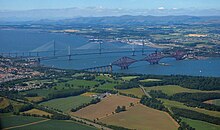Portal:Edinburgh
The Edinburgh Portal
Welcome! — Fàilte! — Walcome!
Edinburgh (/ˈɛdɪnbərə/ ED-in-bər-ə, Scots: [ˈɛdɪnbʌrə]; Scottish Gaelic: Dùn Èideann [t̪un ˈeːtʲən̪ˠ]) is the capital city of Scotland and one of its 32 council areas. The city is located in southeast Scotland and is bounded to the north by the Firth of Forth estuary and to the south by the Pentland Hills. Edinburgh had a population of 506,520 in mid-2020, making it the second-most populous city in Scotland and the seventh-most populous in the United Kingdom. The wider metropolitan area had a population of 912,490 in the same year.
Recognised as the capital of Scotland since at least the 15th century, Edinburgh is the seat of the Scottish Government, the Scottish Parliament, the highest courts in Scotland, and the Palace of Holyroodhouse, the official residence of the British monarch in Scotland. It is also the annual venue of the General Assembly of the Church of Scotland. The city has long been a centre of education, particularly in the fields of medicine, Scottish law, literature, philosophy, the sciences and engineering. The University of Edinburgh, founded in 1582 and now one of three in the city, is considered one of the best research institutions in the world. It is the second-largest financial centre in the United Kingdom, the fourth largest in Europe, and the thirteenth largest internationally.
The city is a cultural centre, and is the home of institutions including the National Museum of Scotland, the National Library of Scotland and the Scottish National Gallery. The city is also known for the Edinburgh International Festival and the Fringe, the latter being the world's largest annual international arts festival. Historic sites in Edinburgh include Edinburgh Castle, the Palace of Holyroodhouse, the churches of St. Giles, Greyfriars and the Canongate, and the extensive Georgian New Town built in the 18th/19th centuries. Edinburgh's Old Town and New Town together are listed as a UNESCO World Heritage Site, which has been managed by Edinburgh World Heritage since 1999. The city's historical and cultural attractions have made it the UK's second-most visited tourist destination, attracting 4.9 million visits, including 2.4 million from overseas in 2018. (Full article...)
Selected location article

The Victoria Swing Bridge is a swing bridge in Leith docks, Edinburgh, Scotland, which carries a dock road (and previously twin railway lines) across the Water of Leith at a point where it is canalised as the Inner Harbour. (Full article...)
Selected images
Selected transportation article
The Union Canal was opened in 1822 and provides an inland waterway link from Edinburgh to Falkirk and from there to Glasgow via the Forth and Clyde Canal. It is currently owned by the public corporation Scottish Canals and chiefly used for leisure purposes. (Full article...)
Selected area article
Bruntsfield is a largely residential area around Bruntsfield Place in Southern Edinburgh, Scotland. In feudal times, it fell within the barony of Colinton. (Full article...)
Selected environment article
The Firth of Forth (Scottish Gaelic: Linne Foirthe) is the estuary, or firth, of several Scottish rivers including the River Forth. It meets the North Sea with Fife to its north and Lothian to its south. (Full article...)
Did you know?
- ... that Prince Philip was the first member of the British royal family to fly in a helicopter?
- ... that East Suffolk Park, a former student hostel in Edinburgh, was once an internment camp for enemy aliens?
Selected arts article

James Grant (1822–1887) was a Scottish novelist and miscellaneous writer.
Grant was born in Edinburgh, Scotland, and was a distant relation of Sir Walter Scott. He was a prolific author, writing some 90 books, including many yellow-backs. Titles included Adventures of an Aide-De-Camp, One of "The Six Hundred", The Scottish Musketeers and The Scottish Cavalier. (Full article...)
Selected education article
List of schools in Edinburgh is a list of schools in the City of Edinburgh council area of Scotland. It lists schools both within Edinburgh itself, and in outlying villages within the local government boundary. (Full article...)
Selected sports article
The Edinburgh derby is an informal title given to any football match played between Scottish clubs Heart of Midlothian (Hearts) and Hibernian (Hibs), the two oldest professional clubs based in Edinburgh, Scotland. The two clubs have a fierce rivalry that dates back to the clubs being founded in the mid-1870s, which makes it one of the longest running rivalries in world football. The first match between the clubs was played on the Meadows on Christmas Day 1875.
The matches are normally played at either Easter Road or Tynecastle. It has been regularly played in the top level of the Scottish football league system, although derbies were played in the second tier during the 2014–15 season. The teams sometimes also play against one another in cup tournaments, such as the Scottish Cup and Scottish League Cup. The clubs have met twice in Scottish Cup finals, in 1896 and 2012, both of which were won by Hearts. (Full article...)
Selected religion article
The Archdiocese of Saint Andrews & Edinburgh (Latin: Archidioecesis Sancti Andreae et Edimburgensis) is an archdiocese of the Latin Church of the Catholic Church in Scotland. It is the metropolitan see of the province of Saint Andrews and Edinburgh, consisting of the additional suffragan sees of Aberdeen, Argyll and the Isles, Dunkeld, and Galloway. The archdiocese is led by Archbishop Leo Cushley, and its cathedral is St Mary's Cathedral, Edinburgh. (Full article...)
Related portals
In the news
No recent news
Associated Wikimedia
The following Wikimedia Foundation sister projects provide more on this subject:
-
Commons
Free media repository -
Wikibooks
Free textbooks and manuals -
Wikidata
Free knowledge base -
Wikinews
Free-content news -
Wikiquote
Collection of quotations -
Wikisource
Free-content library -
Wikiversity
Free learning tools -
Wikivoyage
Free travel guide -
Wiktionary
Dictionary and thesaurus




























































